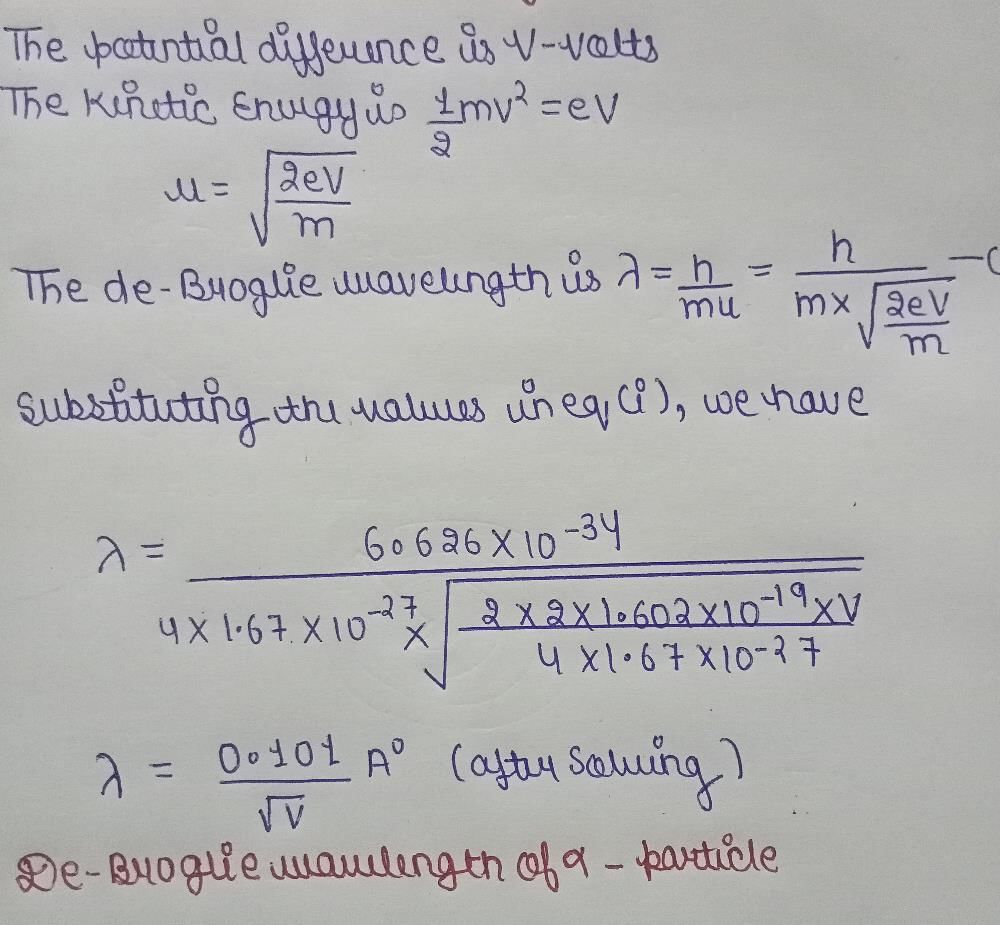Class 12 Exam > Class 12 Questions > An alpha particle is accelerated through a po...
Start Learning for Free
An alpha particle is accelerated through a potential difference of v volts from rest. The de brogil wavelength associated with it is?
Most Upvoted Answer
An alpha particle is accelerated through a potential difference of v v...
Calculation of de Broglie wavelength of alpha particle accelerated through a potential difference of v volts
Explanation
The de Broglie wavelength (λ) associated with a particle is given by the equation:
λ = h/p
where h is Planck's constant and p is the momentum of the particle. For an alpha particle, the momentum can be calculated as:
p = mv
where m is the mass of the alpha particle and v is the velocity it acquires after being accelerated through a potential difference of v volts. The velocity can be calculated using the equation for the kinetic energy:
KE = ½ mv² = qv
where q is the charge on the alpha particle. Since an alpha particle has a charge of +2e, where e is the elementary charge, the kinetic energy can be expressed as:
KE = (2e)(v)
Setting this equal to the potential energy gained by the alpha particle, we have:
qV = (2e)(v)
or
v = (qV)/(2m)
Substituting this expression for v in the equation for the momentum, we get:
p = (2mqV)/(2m) = qV
Finally, substituting the expression for p in the equation for the de Broglie wavelength, we get:
λ = h/p = h/(qV)
Explanation
The de Broglie wavelength of a particle is inversely proportional to its momentum. Therefore, the higher the momentum of a particle, the smaller its de Broglie wavelength. In the case of an alpha particle accelerated through a potential difference, the momentum of the particle can be calculated using the equations for kinetic and potential energy. Substituting this expression for momentum in the equation for the de Broglie wavelength, we can calculate the wavelength associated with the alpha particle. This calculation is useful in understanding the wave-particle duality of matter and its behavior in different physical systems.
Community Answer
An alpha particle is accelerated through a potential difference of v v...


|
Explore Courses for Class 12 exam
|

|
Similar Class 12 Doubts
An alpha particle is accelerated through a potential difference of v volts from rest. The de brogil wavelength associated with it is?
Question Description
An alpha particle is accelerated through a potential difference of v volts from rest. The de brogil wavelength associated with it is? for Class 12 2024 is part of Class 12 preparation. The Question and answers have been prepared according to the Class 12 exam syllabus. Information about An alpha particle is accelerated through a potential difference of v volts from rest. The de brogil wavelength associated with it is? covers all topics & solutions for Class 12 2024 Exam. Find important definitions, questions, meanings, examples, exercises and tests below for An alpha particle is accelerated through a potential difference of v volts from rest. The de brogil wavelength associated with it is?.
An alpha particle is accelerated through a potential difference of v volts from rest. The de brogil wavelength associated with it is? for Class 12 2024 is part of Class 12 preparation. The Question and answers have been prepared according to the Class 12 exam syllabus. Information about An alpha particle is accelerated through a potential difference of v volts from rest. The de brogil wavelength associated with it is? covers all topics & solutions for Class 12 2024 Exam. Find important definitions, questions, meanings, examples, exercises and tests below for An alpha particle is accelerated through a potential difference of v volts from rest. The de brogil wavelength associated with it is?.
Solutions for An alpha particle is accelerated through a potential difference of v volts from rest. The de brogil wavelength associated with it is? in English & in Hindi are available as part of our courses for Class 12.
Download more important topics, notes, lectures and mock test series for Class 12 Exam by signing up for free.
Here you can find the meaning of An alpha particle is accelerated through a potential difference of v volts from rest. The de brogil wavelength associated with it is? defined & explained in the simplest way possible. Besides giving the explanation of
An alpha particle is accelerated through a potential difference of v volts from rest. The de brogil wavelength associated with it is?, a detailed solution for An alpha particle is accelerated through a potential difference of v volts from rest. The de brogil wavelength associated with it is? has been provided alongside types of An alpha particle is accelerated through a potential difference of v volts from rest. The de brogil wavelength associated with it is? theory, EduRev gives you an
ample number of questions to practice An alpha particle is accelerated through a potential difference of v volts from rest. The de brogil wavelength associated with it is? tests, examples and also practice Class 12 tests.

|
Explore Courses for Class 12 exam
|

|
Signup for Free!
Signup to see your scores go up within 7 days! Learn & Practice with 1000+ FREE Notes, Videos & Tests.



















